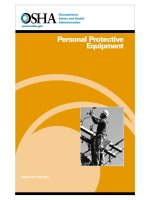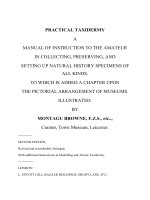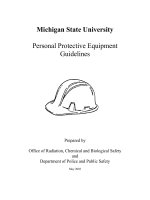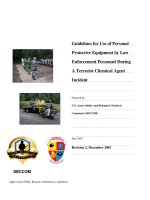PRACTICAL RADIATION TECHNICAL MANUAL PERSONAL PROTECTIVE EQUIPMENT pot
Bạn đang xem bản rút gọn của tài liệu. Xem và tải ngay bản đầy đủ của tài liệu tại đây (438.73 KB, 71 trang )
PRACTICAL
RADIATION
TECHNICAL
MANUAL
PERSONAL PROTECTIVE
EQUIPMENT
PERSONAL PROTECTIVE EQUIPMENT
PRACTICAL RADIATION TECHNICAL MANUAL
PERSONAL PROTECTIVE EQUIPMENT
INTERNATIONAL ATOMIC ENERGY AGENCY
VIENNA, 2004
PERSONAL PROTECTIVE EQUIPMENT
IAEA-PRTM-5
© IAEA, 2004
Permission to reproduce or translate the information
in this publication may be obtained by writing to
the International Atomic Energy Agency,
Wagramer Strasse 5, P.O. Box 100, A-1400 Vienna, Austria.
Printed by the IAEA in Vienna
April 2004
FOREWORD
Occupational exposure to ionizing radiation can occur in a range of industries,
such as mining and milling; medical institutions; educational and research
establishments; and nuclear fuel facilities. Adequate radiation protection of
workers is essential for the safe and acceptable use of radiation, radioactive
materials and nuclear energy.
Guidance on meeting the requirements for occupational protection in accor-
dance with the Basic Safety Standards for Protection against Ionizing
Radiation and for the Safety of Radiation Sources (IAEA Safety Series No.
115) is provided in three interrelated Safety Guides (IAEA Safety Standards
Series No. RS-G-1.1, 1.2 and 1.3) covering the general aspects of occupa-
tional radiation protection as well as the assessment of occupational expo-
sure. These Safety Guides are in turn supplemented by Safety Reports
providing practical information and technical details for a wide range of
purposes, from methods for assessing intakes of radionuclides to optimization
of radiation protection in the control of occupational exposure.
Occupationally exposed workers need to have a basic awareness and under-
standing of the risks posed by exposure to radiation and the measures for
managing these risks. To address this need, two series of publications, the
Practical Radiation Safety Manuals (PRSMs) and the Practical Radiation
Technical Manuals (PRTMs) were initiated in the 1990s. The PRSMs cover
different fields of application and are aimed primarily at persons handling radi-
ation sources on a daily basis. The PRTMs complement this series and
describe a method or an issue related to different fields of application,
primarily aiming at assisting persons who have a responsibility to provide the
necessary education and training locally in the workplace.
The value of these two series of publications was confirmed by a group of
experts, including representatives of the International Labour Organization, in
2000. The need for training the workers, to enable them to take part in deci-
sions and their implementation in the workplace, was emphasized by the
International Conference on Occupational Radiation Protection, held in
Geneva, Switzerland in 2002.
This Practical Radiation Technical Manual was developed following recom-
mendations of a Technical Committee meeting held in Vienna, Austria, in
November 1994 on the development, management and operation of a
personal protective equipment system for use in radioactively contaminated
environments. Major contributions to this PRTM were made by R. Wheelton,
United Kingdom.
CONTENTS
1–3 Restriction of exposure through the use of personal protective
equipment
4–5 Proper use of personal protective equipment
6–7 System of personal protective equipment
8–9 Aprons, gloves and other shields against penetrating radiations
10–11 Laboratory and industrial suits to protect against radioactive
contamination
12 Guide for choosing protective suits
13–14 Use of gloves for protection against radioactive contamination
15–16 Use of footwear for protection against radioactive contamination
17–18 Selection of respiratory protective equipment
19–24 Use of respirators
25–28 Use of breathing equipment
29 Other hazards
30 Warning signs and notices
31 Bibliography
IAEA PRACTICAL RADIATION TECHNICAL MANUAL
PERSONAL PROTECTIVE EQUIPMENT
This Practical Radiation Technical Manual is one of a series that has been
designed to provide guidance on radiological protection for employers, radia-
tion protection officers, managers and other technically competent persons
who have responsibility for ensuring the safety of employees working with
ionizing radiation. The Manual may be used with the appropriate IAEA
Practical Radiation Safety Manuals to provide training, instruction and infor-
mation for all employees engaged in work with ionizing radiation.
1
PERSONAL PROTECTIVE EQUIPMENT
Introduction
Personal protective equipment (PPE) includes clothing or other special equip-
ment that is issued to individual workers to provide protection against actual
or potential exposure to ionizing radiations. It is used to protect each worker
against the prevailing risk of external or internal exposure in circumstances in
which it is not reasonably practicable to provide complete protection by
means of engineering controls or administrative methods. Adequate personal
protection depends on PPE being correctly selected, fitted and maintained.
Appropriate training for the users and arrangements to monitor usage are also
necessary to ensure that PPE provides the intended degree of protection
effectively.
This Manual explains the principal types of PPE, including protective clothing
and respiratory protective equipment (RPE). Examples of working procedures
are also described to indicate how PPE should be used within a safe system
of work.
The Manual will be of most benefit if it forms part of a more comprehensive
training programme or is supplemented by the advice of a qualified expert in
radiation protection. Some of the RPE described in this Manual should be
used under the guidance of a qualified expert.
3
1. RESTRICTION OF EXPOSURE
Workers can be protected against ionizing radiations by using either one or a
combination of the following means:
(A) Engineering controls
(B) Administrative methods
(C) Personal protective equipment (PPE).
Whenever it is reasonably practicable, protection should be provided ‘at the
source’.This may involve selecting a radioactive substance of the most appro-
priate activity and form for a specific application, such as using a source of
the minimum activity necessary and in a physical form that is least likely to
spill. The term also implies that priority should be given to using engineering
controls as a barrier around the source, automatically protecting workers in
the vicinity against external and/or internal exposure. The practice should
preferably be inherently safe by design.
Protection against external exposure may be achieved by using a combina-
tion of shielding and distance. Effective devices and warnings are needed to
ensure that the source remains shielded and/or that the correct distance is
maintained between the source and those who may potentially be exposed to
the radiation hazards. Protection against internal exposure is achieved by
containing radioactive substances and/or preventing their dispersal, to avoid
causing contamination. Containment can be supplemented, if necessary, by
further engineering controls such as extraction ventilation from a point (or
points) close to where any dispersion is likely to occur. High efficiency partic-
ulate air (HEPA) filters incorporated into the ventilation system will remove
radioactive particulates from the extracted air.
Administrative methods are less satisfactory than engineering controls
because their effectiveness relies on the co-operation and awareness of indi-
vidual workers to restrict exposures. For example, exposures might be
restricted by limits on who may enter or on how long workers may remain
inside controlled and supervised areas.
4
5
Engineering controls to contain radioactive material.
A tray is used to provide simple containment for minor spills and drips. A fume hood
is necessary to adequately contain vapours from volatile radioactive substances. The
fume hood must draw a sufficient draught of air to provide adequate
engineering control. A glovebox is necessary to provide total containment during the
manipulation of very hazardous materials such as fine powdered alpha emitters.
2. USE OF PERSONAL PROTECTIVE EQUIPMENT
As an administrative method to restrict exposure or, as a last line of defence,
where neither engineering controls nor administrative methods are reason-
ably practicable, workers should use PPE. The use of PPE may be the only
means of controlling the exposure of workers involved in emergency opera-
tions. PPE includes clothing or other special equipment that is issued to
protect each exposed worker. It is essential that all persons involved in the
management and use of PPE are aware of its capabilities and limitations, in
order to ensure that an adequate, reliable and planned degree of personal
protection is provided.
Different PPE may be used to protect against external and internal exposures.
Protective clothing may be designed to shield large areas of the wearer’s body
or individual organs, such as the eyes, against external irradiation. However,
protective clothing and equipment is more frequently used to prevent radioac-
tive substances either making direct contact with or entering the body and
delivering internal exposures.
Respiratory protective equipment (RPE) is intended to prevent the inhalation
of radioactive substances which would result in radiation doses to the lungs
and other organs into which the substance(s) might ultimately pass or which
might be irradiated by them.
6
7
Administrative controls and PPE in support of engineering controls.
Engineering controls: The bench profile is designed to contain a spill and the
location of the integral sink and the electrical socket minimizes the buildup of
radioactive contamination.
Administrative controls: The warning notice and a tag on the drainpipe to prevent
unauthorized workers entering a contaminated pipe provide administrative controls.
Personal protective equipment is used as a last line of defence.
3. THE SELECTION OF PERSONAL PROTECTIVE
EQUIPMENT
Three essential items of information are necessary before selecting PPE:
(A)
The nature of the exposure.
Both qualitative and quantitative information
is needed about conditions in the workplace. Surveys, as described in
the Manual on Workplace Monitoring for Radiation and Contamination
(IAEA-PRTM-1), can be performed to determine the radionuclide(s)
present, the type of potential exposure(s) and magnitude of possible
doses, the physical form of the radiation source(s), and the nature and
concentration(s) of any contamination. The radiological risks need to be
considered together with other hazards to appreciate the difficulties of
accomplishing the work wearing PPE.
(B)
Performance data for PPE.
Data are needed to assess the ability of
available and/or approved PPE to reduce the particular exposure(s).
This information will usually be available from the manufacturers, who
will have carried out tests under controlled conditions as specified in
international or national regulations and standards.
(C)
The acceptable level of exposure.
PPE should aim to minimize or even
to eliminate exposure. In practice a decision will be made, preferably by
a qualified expert, on whether the PPE could in theory provide adequate
protection below internationally agreed dose limits or other constraints.
8
9
The nature of any potential exposure in the workplace is assessed.
Measurements are made using personal air samplers (belt mounted) and surface
and airborne contamination monitors to assess working conditions. Any
contaminants present need to be analysed to provide information necessary to
select suitable PPE.
4. FITTING, USING AND MAINTAINING PERSONAL
PROTECTIVE EQUIPMENT
Maximum protection will only be obtained in practice if the PPE is fitted, used
and maintained to the standards specified for the manufacturer’s tests.
PPE are manufactured in limited ranges of size for workers of average build,
often of a single gender group only. It may be necessary to try different prod-
ucts of a similar specification to find PPE that is comfortable and a good fit
and that provides the necessary protection. The workers’ training must
emphasize the need to fit and use the personal protection correctly each time.
PPE needs to be routinely cleaned, checked and maintained in accordance
with the manufacturer’s recommendations. The users can be relied upon to
carry out or to arrange for cleaning but appropriate arrangements must be in
place. For example, either there must be a central system for cleaning or suit-
able materials must be supplied, both to encourage the action and to ensure
that unsuitable cleaning methods or agents are not used. A central system for
cleaning facilitates the carrying out of checks, maintenance and repairs. This
maintains the level of protection and helps to prolong the life of the PPE. The
use of disposable PPE reduces the need for maintenance, but it will still be
necessary, for example, to maintain dispensers and to dispose of contami-
nated clothing.
10
11
PPE must be fitted, used and maintained properly.
PPE should be selected to fit individual workers. The training of workers should
emphasize the need to use PPE correctly and equipment should be checked and
maintained regularly.
5. INFORMATION, INSTRUCTION AND TRAINING
The various individuals and groups normally involved in a system in which
PPE is used should all receive adequate information, instruction or training.
Their needs differ but may include the following, for example:
– The manager responsible for the system needs information on appro-
priate surveys, on the selection of suitable equipment and literature from
the manufacturer of the equipment. Management skills are necessary to
set up an appropriate system and to maintain its effectiveness in prac-
tice.
– Workers need instruction on the specific hazards of the workplace and
the consequences of unprotected exposure. Their training should
include where, when and how protective equipment is obtained, fitted,
used and cleaned.They will also need to recognize faulty equipment and
hazards which may arise from use of the equipment.
– Storekeepers need to know how to store and issue the correct equip-
ment properly.
– Maintenance and cleaning staff need to be trained in how to clean
equipment properly, how to assess damage and wear, and how to
ensure effective repair or replacement. The potential exposure of
cleaning staff must be taken into account.
– Supervisors need all of the above and clear instructions which define
their responsibilities. They need to provide for refresher training and to
ensure that recruits to the system receive appropriate and adequate
initial information, instruction and training.
12
13
Workers should be trained to use PPE.
Managers, users, storekeepers, maintenance staff and supervisors will have specific
requirements for appropriate information, instruction and training.
6. MANAGEMENT OF A SYSTEM OF PERSONAL
PROTECTIVE EQUIPMENT
The effectiveness of PPE depends on good management, supervision and
monitoring of the system. The system needs to be defined in written proce-
dures with the full support and commitment of senior management. PPE may
make work more difficult or more demanding and may not be popular with all
workers. Managers and supervisors need to recognize this and to set an
example by using personal protection whenever, and for however short a time,
they enter areas in which the system is in place.
Supervisors need to monitor whether the protective equipment is being used
correctly and consistently; whether it is being cleaned and maintained; and
whether provisions for training are being utilized and are adequate. They also
need to be alert to possible problems, such as changes in conditions that
might render the PPE inadequate, or hazards which the PPE might create or
exacerbate (see Section 29).
Supervisors and workers need to keep managers informed of changes in the
workplace or processes and changes or improvements in available PPE.
There must be clear guidelines for any disciplinary action(s) that would be
taken against workers who do not comply with obligations under the system.
14
15
A system of work involving PPE has to be properly managed.
To ensure that it provides the intended protection, a system of work has to be set
down in writing and everyone involved in it has to comply with the requirements. The
system has to be adapted to meet changes as they arise.
7. DESIGNATED AREAS
Whenever there is a potential for occupational exposure to ionizing radiation,
a prior evaluation of the radiological risks is necessary in order to consider the
need for classifying the working area. Workplaces are designated as
controlled areas if specific protective measures or safety provisions are or
could be required for:
(A) Controlling exposures or preventing the spread of contamination in
normal working conditions, and
(B) Preventing or limiting the extent of potential exposures.
Although specific protection measures and safety provisions are not normally
necessary, the working area is classified as a supervised area if it is not
already designated as a controlled area but if the conditions of occupational
exposure need to be kept under review.
The system of work for a designated area should include the use of PPE if its
use would be reasonably practicable, and if it would potentially either reduce
the doses to those who work in the area or prevent the dispersal of contami-
nation from the designated area. If the protective equipment is essential,
access to the area must be restricted and the PPE should be specified as a
condition of entry, such as on a written permit to work in the area. Under these
circumstances barrier discipline is essential.
Routine and task related monitoring should be performed as described in the
Manual on Workplace Monitoring for Radiation and Contamination (IAEA-
PRTM-1). The Manual on Individual Monitoring (IAEA-PRTM-2) describes
methods to verify the effectiveness of the practices for control of radiation.
The validity of using PPE and the possibility of replacing it with more suitable
engineering controls or redesigned processes should be considered in
regular assessments.
16
17
Specific protective measures or safety provisions apply in controlled areas.
The extent of controlled areas should be clearly defined. Where practicable, the
boundaries coincide with fixed barriers, such as the walls and doors of a room.
Notices are posted to display appropriate warnings and to prohibit unauthorized
access.
8. APRONS TO PROTECT AGAINST PENETRATING
RADIATIONS
Flexible aprons with a thickness up to the equivalent of 1/3 mm of lead (written
as 0.33 mmPb) are available to shield the upper torso. Double sided aprons
shield the chest and the back against radiations scattered behind the body.
The aprons attenuate, by about 90%, low energy radiations such as scattered
X rays (of tens of keV). However, these aprons are ineffective against the
more penetrating primary X rays and gamma radiations (above 100 keV) used
more widely in nuclear medicine, radiotherapy and industry.
Wearing an apron for prolonged periods is tiring, which is why garments do
not incorporate more substantial shielding. The aprons are cumbersome and
may slow down work and thus result in higher personal doses if they do not
provide adequate protection.
Aprons must be stored flat or on rounded hangers. Folding or creasing causes
cracks or wear in the shielding. Such damage, although minor, may lead to
repeated exposure of the same area of the body. An outer fabric cover may
need to be removed to inspect the shielding visually. More thorough exami-
nations, including radiographic or fluoroscopic tests, should be carried out
periodically (annually). Damaged aprons should be discarded or clearly
labelled as being only for uses other than as a body radiation shield.The outer
cover can usually be wiped clean with water and mild detergent.
18
19
Protective aprons in use and storage.
Aprons provide insignificant protection against the more penetrating radiations.
Inappropriate use of aprons can increase personal exposures. Storage conditions
and checks are essential to avoid using damaged aprons.









